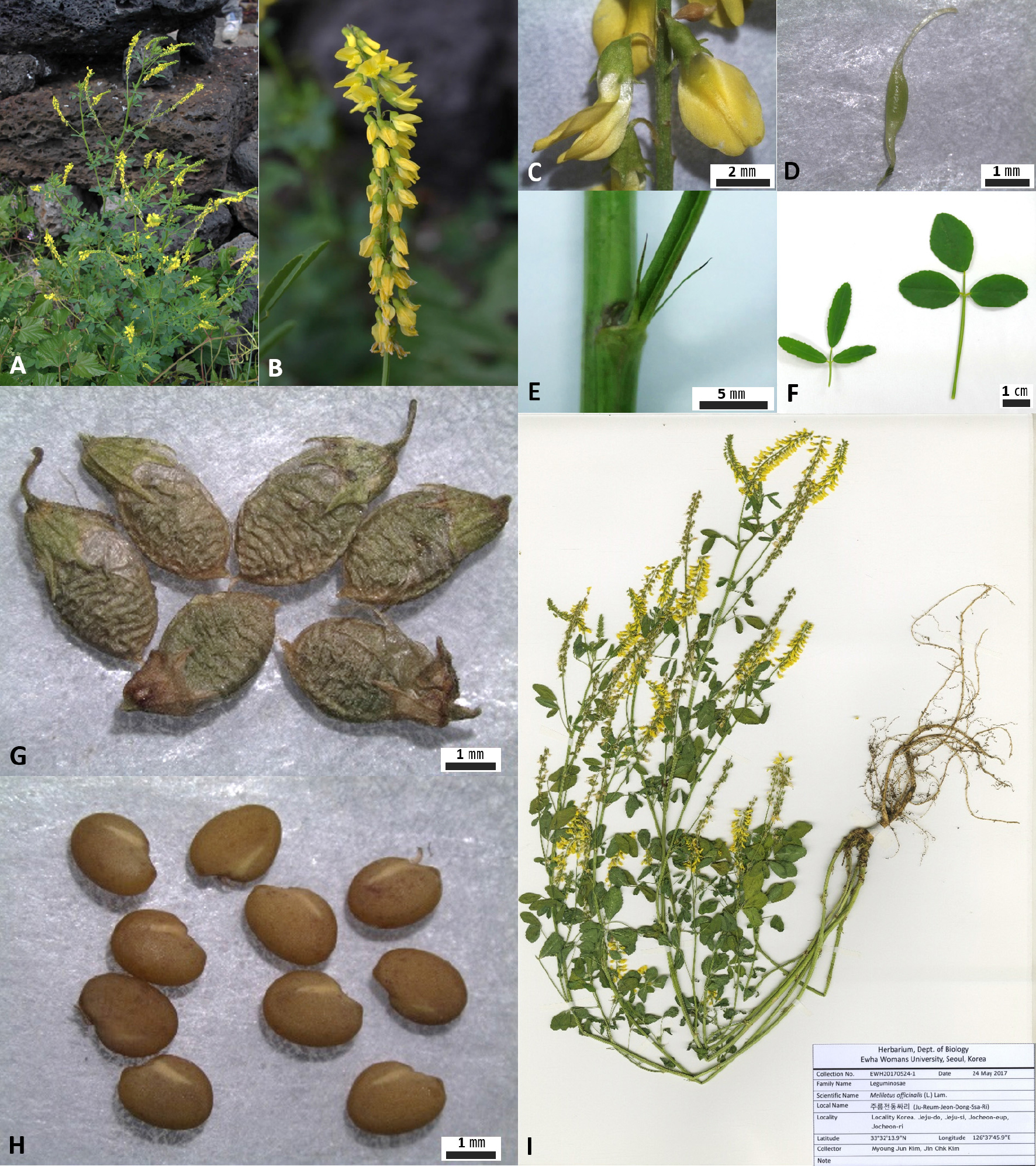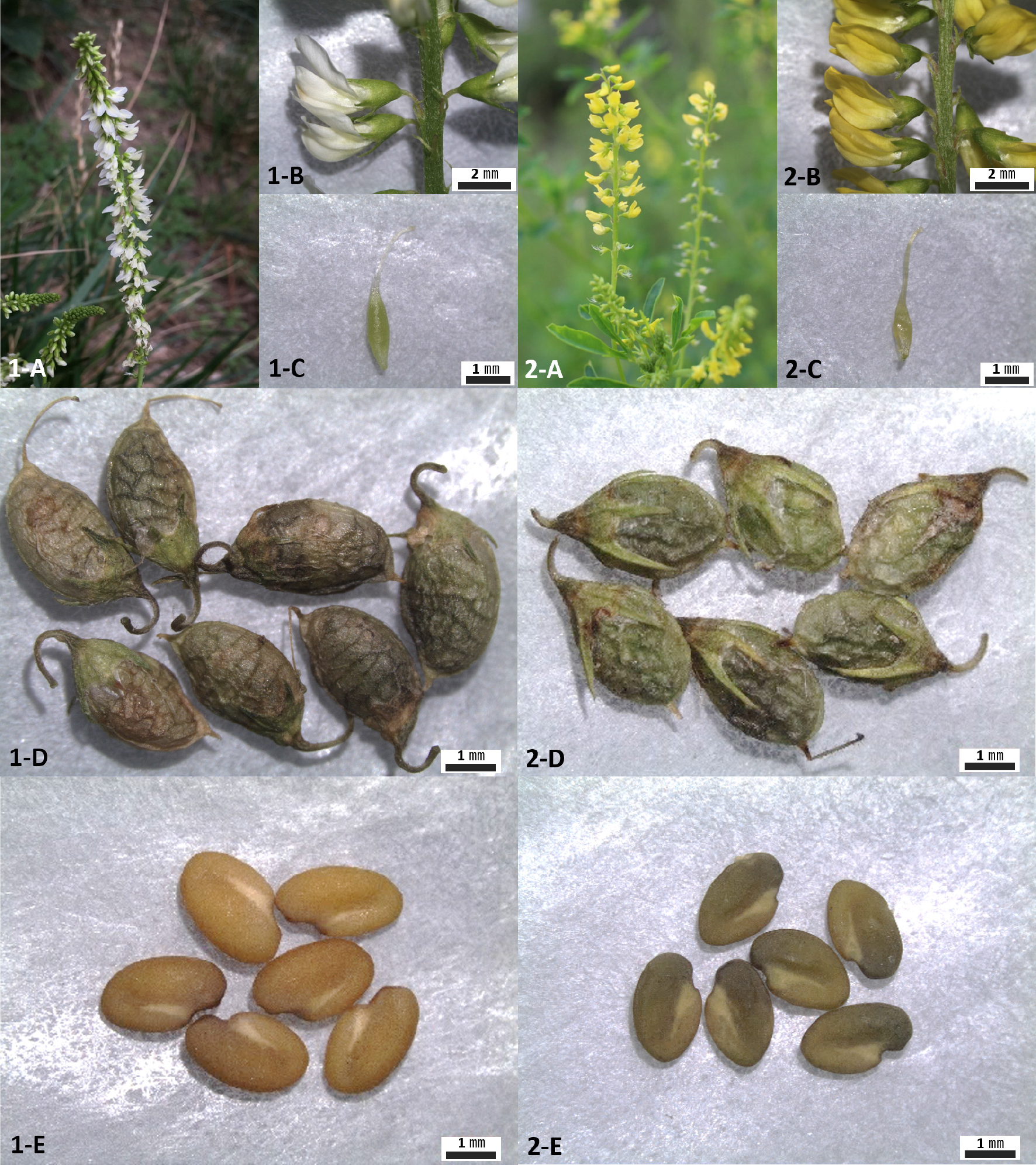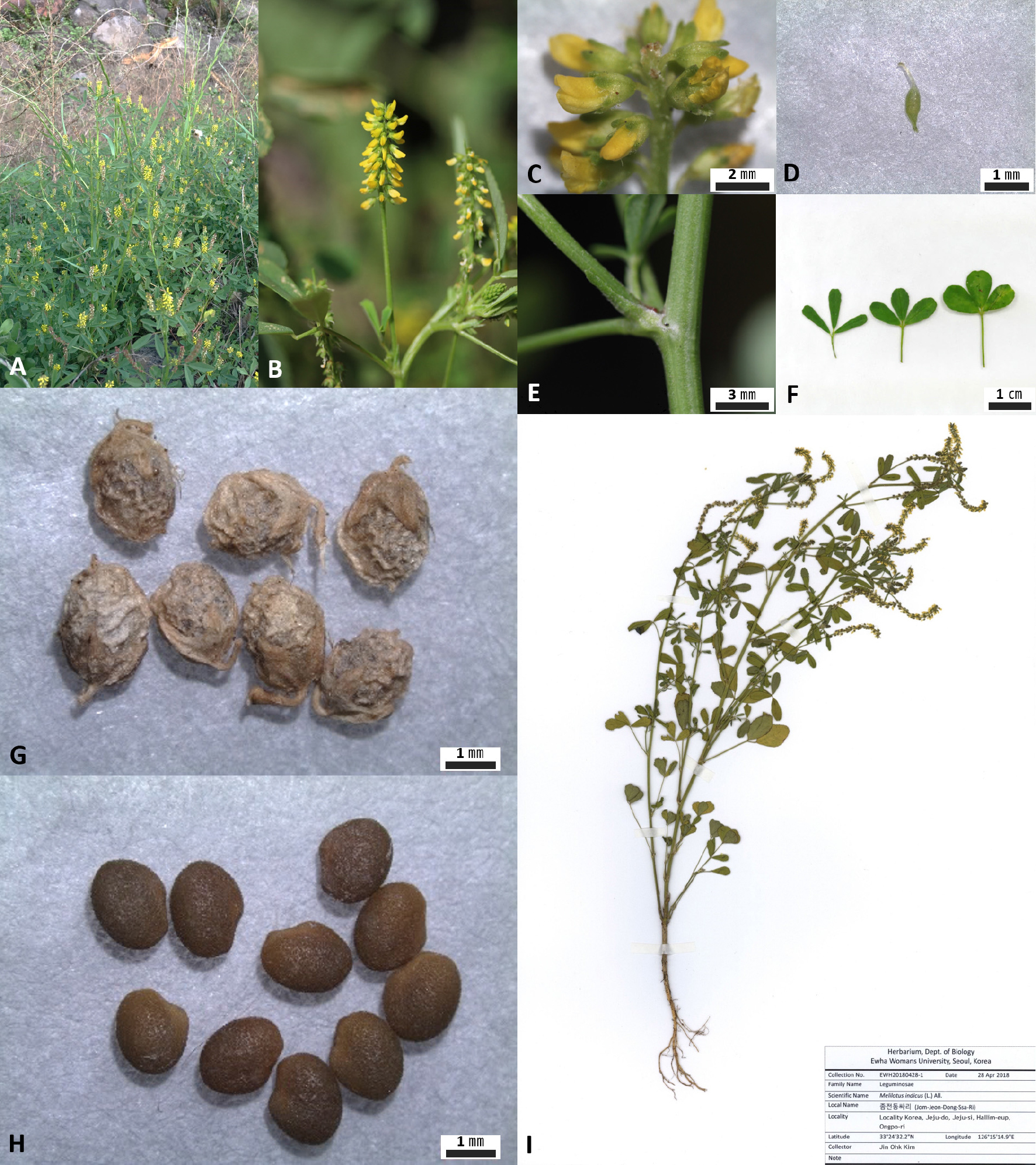Introduction
The genus Melilotus (L.) Mill. (Leguminosae) is comprised about 20 species in temperate and subtropical regions of Eurasia, and North Africa (Isely, 1954; Kita, 1965; Choi, 2007). Several species of the genus Melilotus are widely cultivated for soil improvement and naturalized throughout the world (Kita, 1965; Di et al., 2015). In Korea, two taxa of Melilotus have been reported: M. albus Medik. (Huin-jeon- dong-ssa-ri) and M. suaveolens Ledeb. (Jeon-dong-ssa-ri) (Lee, 2006; Choi, 2007; Park, 2009; Kim et al., 2017). Both taxa are native to Eurasia and have been introduced to Korea as naturalized plants (Jung et al., 2017).
Recently, M. officinalis (L.) Lam. and M. indicus (L.) All. were observed in Jeju island, Korea. They are native to Eurasia and Mediterranean-Southwestern Europe, respectively. The local name of M. officinalis and M. indicus were given as “Ju-reum-jeon-dong-ssa-ri” and “Jom-jeon-dong-ssa-ri” based on transverse nerved legumes and its overall smaller size than M. suaveolens, respectively.
Materials and Methods
In this study, we reported two unrecorded alien plants, M. officinalis and M. indicus which observed in Jeju island as naturalized plants in Korea. The descriptions on morphological characters, photographs at the habitat, and a key to allied taxa in Korea of M. officinalis and M. indicus were provided (Fig. 1-3). The morphological comparison among M. albus, M. suaveolens, M. officinalis, and M. indicus was also provided (Table 1). The examined specimens were listed in Appendix 1.
Results and Discussion
Taxonomic treatment
Melilotus officinalis (L.) Lam., Fl. Franc. 2: 594, 1779
Trifolium officinale L., Sp. Pl. 2: 765. 1753 [T. “M. officinalis”]
Plants biennial herbs, 40-100(-150) ㎝ tall, slightly pubescent to glabrescent. Stems erect, branched. Stipules linear-filiform, 8-12 ㎜ long, entire or with 1 tooth at base. Leaves alternate, pinnately 3-foliolate, leaflet broadly oval to oblong-lanceolate, 15-25 ㎜ long, glabrous adaxial, sparsely pubescent abaxial, lateral veins 10-13 pairs, running into teeth. Racemes axillary, 4-15(-20) ㎝ long, elongate after anthesis, 30-80 flowers; bracts filiform, 1.5-2 ㎜ long; pedicels equal to bracts. Flowers yellow, 4-7 ㎜ long; standard larger than wings and keel; calyx 2-3 ㎜ long, teeth lanceolate; ovary narrowly ovate, definite stalk; ovules (4-)5-8. stamens 10(9 filaments fused, 1 free); pistil 1. Legumes yellowish brown at maturity, indehiscent, ovoid-elliptic, apex acute, style persist, 3-4 ㎜ long, glabrous, transverse nerved surface. Seeds 1-2, yellowish-brown, elliptic to ovate, about 2.5 ㎜ long, smooth. Flowering May to Sep. Chromosome numbers 2n = 16 (Ferrarella et al., 1981; Schlarbaum et al., 1984).
Korean name: Ju-reum-jeon-dong-ssa-ri (주름전동싸리)
Distribution: Native to Eurasia; Introduced to North America and widely distributed in agricultural regions throughout the world (Isely, 1954); Habitat grasslands, hillsides, ravine shores, margins of mixed woodlands (Vincent and Wei, 2010); KOREA: Gangwon-do, Gyeonggi-do, Gyeongsangbuk-do, Jeju-do, and Seoul based on localities of the examined specimens (Appendix 1); Observed in open places and roadsides of coastlines with Raphanus sativus var. hortensis f. raphanistroides, Vitis ficifolia var. sinuata, Rumex crispus, Vitex rotundifolia, Chenopodium album var. centrorubrum, Sagina japonica in Jocheon-up, Jeju-si, Jeju-do, Korea.
Voucher specimens: Korea. Jeju-do, Jeju-si, Jocheon-eup, Jocheon-ri, 24 May 2017, EWH20170524 (Fig. 1, 11 sheets).
Notes: Since M. officinalis is similar in morphology to M. suaveolens, it has been mistaken for M. suaveolens. As a result of examining the specimens of the National Korea Arboretum, Ewha Womans University, and Ewha Womans University Natural History Museum (Appendix 1), M. officinalis was misidentified as M. suaveolens. In fact, it is difficult to distinguish between M. officinalis and M. suaveolens. Because they are very closely related and had been separated by trivial characters (Ohashi et al., 1984). Therefore Vincent and Wei (2010) and Ohashi et al. (1984) treated M. suaveolens as synonym of M. officinalis and M. officinalis for. suaveolens, respectively. However, M. officinalis has transverse nerved legumes (Fig. 1. G) and ovary with 5 or 6(-8) ovules (Table 1) while M. suaveolens has reticulate nerved legumes (Fig. 3. 2-D) and ovary with 2-4 ovules (Schulz, 1901; Polozhij and Malyschev, 2006). Komarov (1945) also classified them as separate species based on the number of ovules in ovary; M. officinalis and M. suaveolens have 4-8 and 2-3(-4) ovules in ovary, respectively. In addition, M. officinalis has definite ovary stalks (Fig. 1. D) while M. suaveolens has sessiled one (Fig. 3. 2-C) (Isely, 1954; Stevenson, 1969). Therefore, M. officinalis is distinguished from M. suaveolens by transverse nerved of legume surface, definite ovary stalks, and 5-8 numbers of ovules in ovary. In the recent study of Zhang et al. (2018), M. officinalis and M. suaveolens were also treated as each separate species based on 5 DNA sequences. The introduction time of M. officinalis is uncertain, but according to the examined specimens, M. officinalis has been naturalized in South Korea at least since 2003.
Table 1. The morphological comparison among Melilotus albus, M. suaveolens, M. officinalis, and M. indicus
Melilotus indicus (L.) All., Fl. Pedem. 1: 308, 1785.
Trifolium indicum L., Sp. 2: 765. 1753 [T. “M. indica”]
Plants annual, slightly pubescent to glabrescent. Stems erect or ascending, 20-50 ㎝ tall, branched base. Stipules lanceolate, dilated at base, 4-6 ㎜ long, base auriculate, with 1-2 tiny teeth, margin membranous. Leaves alternate, pinnately 3-foliolate, leaflet obovate-cuneate to narrowly oblong, 1-2 ㎝ long, glabrous adaxial, sparsely pubescent abaxial, lateral veins 7-9 pairs, running into teeth, margins serrate toward apex, apex obtuse or truncate, sometimes retuse, base cuneate. Racemes axillary, slender, dense, 1-5 ㎝ long, elongate after anthesis, 10-40 (-50) flowers; bracts filiform; pedicels 0.5-1 ㎜ long. Flowers yellow, 2-3 ㎜ long; standard ovate, retuse, equal to wings and keel; calyx teeth broadly triangular, 1-1.3 ㎜ long; ovary narrowly ovate, subsessile; ovules 2; diadelphous stamens 10(9 filaments fused, 1 free); pistil 1. Legumes light brown at maturity, indehiscent, ovoid to globose, about 2 ㎜ long, glabrous, reticulate nerved surface. Seeds 1-2, yellowish-brown, elliptic to ovate, minutely papillose, about 1.5 ㎜ long. Flowering March to May. Chromosome numbers 2n = 16 (Ferrarella et al., 1981; Schlarbaum et al., 1984).
Korean name: Jom-jeon-dong-ssa-ri (좀전동싸리)
Distribution: Native to Mediterranean and Southwestern Europe (Shimizu, 2003); Naturalized in temperate regions all over the world (Shimizu, 2003); Habitat open places, roadsides, coastlines, meadows, wastelands (Schulz, 1901; Vincent and Wei, 2010). KOREA: Jeju-do and Seoul based on localities of the examined specimens (Appendix 1); Observed in open places and roadsides of coastlines with Vitis ficifolia var. sinuata, Rumex crispus, Vitex rotundifolia, Chenopodium album var. centrorubrum, Sagina japonica, Setaria vridis, Eremochloa ophiuroides, Artemisia capillaris in Hallim-eup, Jeju-si, Jeju-do, Korea.
Voucher specimens: Korea, Jeju-do, Jeju-si, Hallim-eup, Ongpo-ri, 28 Apr. 2018, EWH20180428 (Fig. 2, 6 sheets).
Notes: As in the case of M. officinalis, M. indicus also has been mistaken for M. suaveolens. However, it is distinguished from M. suaveolens (Fig. 3) by smaller size of flowers, broadly triangular calyx teeth, globose legumes, and minutely papillose seeds (Fig. 2). In addition, the flowering period of M. indicus is March to May, while that of M. suaveolens is May to September (Table 1). The introduction time of M. indicus is uncertain, but according to the examined specimens, M. indicus has been naturalized in South Korea at least since 1957.
Key to taxa of genus Melilotus in Korea.
1. Flower 2-3 ㎜ long; calyx teeth broadly triangular; seeds papillose…………………………………………M. indicus 좀전동싸리
1. Flower longer than 3.5 ㎜; calyx teeth lanceolate; seeds smooth.
2. Flower white…………………………………………………………………………………………………………………………M. albus 흰전동싸리
2. Flower yellow.
3. Flowers 4-7 ㎜ long; ovule number 5-8; legume surface transverse nerved…………M. officinalis 주름전동싸리
3.Flowers 3.5-4.5 ㎜ long; ovule number 2-4; legume surface reticulate nerved…………M. suaveolens 전동싸리
Appendix 1. A list of specimens examined in this study.
Melilotus albus Medik. (흰전동싸리) KOREA. Gangwon-do: Gangneung-si, Okgye-myeon, Mt. Seokbyeong-san, 04 Jun. 2006 (KHB1127636); Samcheok-si, 21 Jun. 2017 (EWH20170621-1~EWH20170621-4)
M. indicus (L.) All. (좀전동싸리) KOREA. Jeju-do: 10 Jun. 1983 (ENHA200508012094); 11 Sep. 2001 (KHB1106828); Jeju-si, Gujwa-eup, Gimnyeong-ri, Gimnyeong Coast, 12 May 2012 (KHB1363133); Jeju-si, Hallim-eup, Geumneung-ri, Jeongwoloreum, 13 May 2009 (KHB1310831, KHB1310839); Jeju-si, Hallim-eup, Ongpo-ri, 05 Jul. 2017 (EWH20170705-1~EWH20170705-4); Jeju-si, Hallim-eup, Ongpo-ri, 28 Apr. 2018 (EWH20180427-1~EWH20180427-6); Jeju-si, Hangyeong-myeon, Dumo-ri, 20 Jun. 2014 (KHB1469065). Seoul: Seodaemun-gu, Daehyeon-dong, Ewha Womans University, 18 May 1957 (EWUA200009061024); Seodaemun-gu, Daehyeon-dong, Ewha Womans University, 12 Jun. 1957 (EWUA200009061025, EWUA200009061026); Seodaemun-gu, Daehyeon-dong, Ewha Womans University, 15 Jun. 1957 (EWUA200009061029); Seodaemun-gu, Yeonhui-dong, 15 Jun. 1957 (EWUA200009061028)
M. officinalis (L.) Lam. (주름전동싸리) KOREA. Gangwon-do: Pyeongchang-gun, Bongpyeong-myeon, Mt. Cheongtae-san, 29 Jun. 2008 (KHB1322848); Yangyang-gun, Hyeonnam-myeon, Sangwoncheon-ri, Mt. Manwol-san, 24 Jun. 2008 (KHB1499187). Gyeonggi-do: Ansan-si, Danwon-gu, Isl. Seongam-do, 22 Jun. 2011 (KHB1338105); Paju-si, Gyoha-eup, Sannam-ri, Sannam Wetland, 14 Jun. 2011 (KHB1323924); Yeoju-si, 04 Jun. 2017 (EWH20170604-1~EWH20170604-5). Gyeongsangbuk-do, Ulleung-gun, Seo-myeon, Namseo-ri, 25 Jun. 2009 (KHB1332454). Jeju-do: Jeju-si, Jocheon-eup, Jocheon-ri, 24 May 2017 (EWH20170524-1~EWH20170524-11). Seoul: Mapo-gu, Sangam-dong, Worldcup Park, Haneul Park, 19 May. 2004 (KHB1074375); Mapo-gu, Sangam-dong, Worldcup Park, Haneul Park, 07 May 2005 (KHB1088824); Mapo-gu, Sangam-dong, Worldcup Park, Haneul Park, 30 May 2009 (KHB1236737); Mapo-gu, Sangam-dong, Worldcup Park, Haneul Park, 02 Jun. 2010 (KHB1297505); Mapo-gu, Sangam-dong, Worldcup Park, Top of the Noneul Park, 23 May 2003 (KHB1082779); Mapo-gu, Sangam-dong, Worldcup Park, Noneul Park, 06 Jun. 2008 (KHB1214876)
M. suaveolens Ledeb. (전동싸리) KOREA. Busan: Saha-gu, Hadan-dong, Isl. Eulsuk-do, 22 Aug. 2008 (KHB1214721). Chungcheongbuk-do: Jecheon-si, Deoksan-myeon, Mt. Worak-san, 05 Aug. 2005 (KHB1539983); Danyang-gun, Yeongchun-myeon, Mt. Sobaek-san, 03 Jul. 2005 (KHB1539922). Chungcheongnam-do: Boryeong-si, Jusan-myeon, Jeungsan-ri, 21 Jun. 2013 (KHB1427818); Seocheon-gun, Biin-myeon, 20 Jul. 1971 (EWUA200009061030~EWUA200009061033); Taean-gun, Wonbuk-myeon, Banggal-ri, 07 Sep. 2005 (KHB1093166). Daegu: Suseong-gu, Pa-dong, 27 May 2011 (KHB1324840). Gangwon-do: Gangneung-si, Okgye-myeon, Mt. Seokbyeong-san, 09 Sep. 2006 (KHB1136369, KHB1136370); Goseong-gun, Hyeongne-myeon, Sacheon-ri, 03 Jul. 2008 (KHB1542357); Hoengseong-gun, Anheung-myeon, Jigu-ri, Mt. Obong-san, 17 Jun. 2008 (KHB1322296); Hwacheon-gun, Mt. Il-san, 16 Oct. 2008 (KHB1311651); Jeongseon-gun, Gohan-eup, Geumdaebong 24 Jul. 2008 (KHB1499197, KHB1499198); Jeongseon-gun, Sabuk-eup, Mt. Nomok, 23 Jul. 2008 (KHB1499195); Jeongseon-gun, Yeoryang-myeon, Mt. Ballon-san, 27 Jul. 2010 (KHB1307267, KHB1308923); Jeongseon-gun, Yimgye-myeon, Goyang-ri, Mt. Munrae-san, 05 May 1977 (EWUA200009061037~EWUA200009061045); Pyeongchang-gun, Mitan-myeon, Mt. Cheongok, 04 Sep 2008 (KHB1323117); Samcheok-si, Gagok-myeon, Punggok-ri, Mt. Eungbong-san, 17 Jul. 2008 (KHB1320606); Taebaek-si, Mt. Hambaek, 29 Aug. 2008 (KHB1499194); Taebaek-si, Mt. Taebaek, 30 Jul. 2002 (KHB1060180); Yeongwol-gun, Jungdong-myeon, Jikdong-ri, Mt. Maebong-san, 28 Jul. 2007 (KHB1204238); Yeongwol-gun, Sangdong-eup, Naedeok-ri, Mt. Jang-san, 22 Aug. 2012 (KHB1418879); Yeongwol-gun, Yeongwol-eup, Donggang river, 06 Sep. 2007 (KHB1170162, KHB1170163). Gyeonggi-do: Ansan-si, Danwon-gu, Isl. Tan-do, 06 Oct. 2011 (KHB1340464); Hwaseong-si, Songsan-myeon, 01 Aug. 2008 (KHB1202149); Siheung-si, Isl. Oi-do, 04 Sep. 1982 (EWUA200009061047); Yeoju-si, Ganam-eup, Daesin-ri, 30 Jun. 1972 (EWUA200009061034~EWUA200009061036). Gyeongsangbuk-do: Bonghwa-gun, Seokpo-myeon, Mt. Myeon-san, 26 Jul. 2009 (KHB1253599); Danyang-gun, 28 Jul. 1984 (EWUA200009061049). Incheon: Ganghwa-gun, Gyodong-myeon, Nanjeong reservoir, 24 Sep. 2009 (KHB1267070); Ganghwa-gun, Samsan-myeon, Maeeum-ri, Isl. Seokmo-do, 14 Sep. 2006 (KHB1142975); Namdong-gu, Nonhyeon-dong, Sorae port, 29 Jun. 2008 (KHB1203573, KHB1203574); Ongjin-gun, Bukdo-myeon, Sido-ri, 24 Jul. 2004 (KHB1275740); Ongjin-gun, Deokjeok-myeon, Jin 2-ri 830, 01 Oct. 2014 (KHB1473842); Ongjin-gun, Yeongheung-myeon, Oe2-ri, Isl. Seonjae-do, 24 Aug. 1999 (KHB1288743); Ongjin-gun, Isl. Baeknyeong-do, Sagot Nature Airport, 04 Sep. 2006 (KHB1121358, KHB1121359); Seo-gu, Bukhang harbor, 03 Aug. 2010 (KHB1298577); Jung-gu, Unbuk-dong, Isl. Yeongjong-do, Yedanpo, Manseok embankment, 15 Sep. 2009 (KHB1265631, KHB1265632). Jeju-do: Jeju-si, Iho-dong, Iho Tewu Beach, 16 Aug. 1978 (EWUA200009061046); Jeju-si, Sugeun-dong 12 Aug. 1991 (EWUA200009061050). Jeollanam-do: Goheung-gun, Bongnae-myeon, Isl. Oenaro-do, Dongwang village, 06 Sep. 2011 (KHB1350737); Goheung-gun, Bongnae-myeon, Isl. naro-do, 23 Jul. 1982 (ENHA200508012095); Gunsan-si, Okdo-myeon, Seonyudo-ri, 16 Sep. 2010 (KHB1357876); Yeonggwang-gun, Nagwol-myeon, Isl. Anma-do, 09 Sep. 2010 (KHB1303914). Seoul: Mapo-gu, Sangam-dong, Worldcup Park, Haneul Park, 17 Jul. 2008 (KHB1215353); Mapo-gu, Sangam-dong, Worldcup Park, Haneul Park, 09 Aug. 2009 (KHB1264922); Mapo-gu, Sangam-dong, Worldcup Park, Noeul Park, 14 Jul. 2005 (KHB1090805); Mapo-gu, Sangam-dong, Worldcup Park, Noeul Park, 08 Aug. 2009 (KHB1264845)







